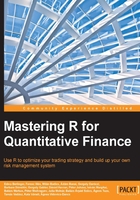
Chapter 2. Factor Models
In most of the cases in finance, valuation of financial assets is based on the discounted cash flow method; hence, the present value is calculated as the discounted value of the expected future cash flows. Therefore, in order to be able to value assets, we need to know the appropriate rate of return that reflects the time value of money and also the risk of the given asset. There are two main approaches to determine expected returns: the capital asset pricing model (CAPM) and the arbitrage pricing theory (APT). CAPM is an equilibrium model, while APT builds on the no-arbitrage principle; thus, these approaches have quite different starting points and inner logic. However, the final pricing formula we get can be quite similar, depending on the market factors we use. For the comparison of CAPM and APT, see Bodie-Kane-Marcus (2008). When we test any of these theoretical models on real-world data, we perform linear regressions. This chapter focuses on APT, since we have discussed CAPM in more detail in Daróczi et al. (2013).
This chapter is divided into two parts. In the first part, we introduce the theory of APT in general, and then we present a special three-factor model published in a seminal paper of Fama and French. In the second part, we show how to use R for data selection and how to estimate the pricing coefficients from real market data, and finally we re-examine the famous Fama-French model on a more recent sample.